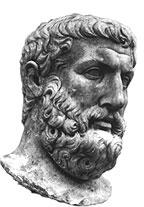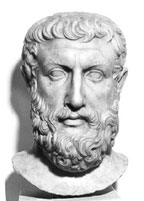|

Parmenides and Zeno
Zeno of Elea was an ancient philosopher who lived
even before Socrates and Plato. Zeno's teacher was named Parmenides, who
believed and taught that the universe is one, and that its contents are
unlimited. Parmenides, at the age of sixty five, is said to have met a young
Socrates in Athens.
Throughout history there have been many
philosophers who have believed in the limitlessness of space, however,
Parmenides uniquely taught that time is infinite, without beginning, end, or
middle.
Parmenides believed everything must exist, which
meant to him that change was an optical illusion of some kind. Since both past
and future already exist, he argued that the passing of time must be unreal. And
so Parmenides denied change, saying it was appearance only, and interestingly
out of the same principle taught that existence or being is ultimately a
oneness. Existence could not be created and was indestructible. He may have been
the first western philosopher to describe the universe as a permanent single
whole, rather than a product of many parts.
This radical ideology did of course lead other
philosophers to look for inconsistencies in Parmenides philosophy of monism and
timelessness, especially since pluralism and change in everyday life are so much
more evident than oneness. Zeno most notably responded by vigorously defending
his teacher Parmenides with ingenious arguments about space and time.
Zeno's most popular paradox was meant to show that
change is impossible, because space is infinitely divisible. To explain, imagine
we take an orange and hold it about waist high from a hard floor. Now we drop
the orange. Unless we are in outer space, the orange will fall and smack the
ground, coming to rest in contact with the floor. But why is the orange able to
move through space if space is infinitely divisible.
Lets try it again, but this time as we drop the
orange mentally we divide the distance to the ground in half, and keeping hold
of the orange, we move it half way to the floor. Now we divide the remaining
distance to the floor in half again and move the orange that distance. Then we
do the same thing again, and again as many times as we can, always dividing the
distance in half.
We could, if we were perfectly accurate, continue
to do this over and again, since hypothetically we can always divide the
remaining distance in half no matter how small the distance to the floor
becomes. The orange should never hit the floor when dropped, the speed of the
orange being irrelevant. Space can be divided in half an infinite number of
times, and so the orange must travel an infinite distance, simply to move at
all.
If we drop the orange it does hit the floor, but as
we try to bridge the gap between the upraised orange and the floor using linear
time and space within our minds, we end up trapped within an infinity of moves
and an innumerable group of infinitely small points. In fact, if both time and
space is linear the orange should not move even an inch away from where it is
upraised, because the first inch the orange tries to move also can be divided
infinitely. And the first millimeter can be divided infinitely. Thus if time is
linear and so infinitely divisible, the way space is infinitely divisible, the
orange would never be able to move at all, no matter what force impaled it.
It appears from Zeno's paradox that either time or
space must not be linear and so not be infinitely divisible, that is, in order
for our universe to change. But instead of concluding that what we experience as
time or space is broken, Zeno simply argued that those moments were not
numerable, but infinite, and so ultimately were one whole. Zeno believed any
other view would divide the world into numerable parts.
Zeno's argument is twofold. First he believed that
if there are separate worlds, then we should be able to say how many actually
exist. So he took the next step and argued the many worlds of an infinite
universe are actually one single undivided world that never changes.
 Where Zeno and Parmenides both advocate a single
reality of oneness, not inconsistent with what Giordano Bruno believed, both
intuitively define the universe as the whole of what is possible, or the one
reality view. The philosophers who recorded their belief in many worlds
consistently described one reality, which should be of no surprise, since those
who are or were agnostic would not try to define the ultimate universe as Bruno
and the others attempted. Zeno could not explain why we observe the world to
change, or why it did so consistently with a good deal of orderliness, and so
the view of an undivided oneness, taught by Xenophanes, and Parmenides at the
school of Elea in Italy, did not become the prominent view of their time, but
Zeno's paradoxes that explore the infinite are still considered unsolved puzzles
in modern times. Where Zeno and Parmenides both advocate a single
reality of oneness, not inconsistent with what Giordano Bruno believed, both
intuitively define the universe as the whole of what is possible, or the one
reality view. The philosophers who recorded their belief in many worlds
consistently described one reality, which should be of no surprise, since those
who are or were agnostic would not try to define the ultimate universe as Bruno
and the others attempted. Zeno could not explain why we observe the world to
change, or why it did so consistently with a good deal of orderliness, and so
the view of an undivided oneness, taught by Xenophanes, and Parmenides at the
school of Elea in Italy, did not become the prominent view of their time, but
Zeno's paradoxes that explore the infinite are still considered unsolved puzzles
in modern times.
Find out more about timelessness at:
EverythingForever.com |
